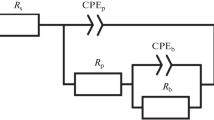Abstract
Organic coatings (films), modified with nonorganic anions, are widespread as means of protection of active metals from corrosion in the aggressive industrial environments. It has been established that these films demonstrate high through electrical conductivity and negative electrical capacitance at frequencies of the audio range. The frequency dependence of film samples with negative capacity seems unique. At the decrease of the frequency of the measuring electric field, the capacity module sharply increases and then, after reaching the value of a few tens or even hundreds of microfarads, remains unchanged within a certain low-frequency range. Such a frequency dependence of the capacity confirms that the negative capacity of the films occurs due to the development of relaxation polarization at the inverse intensity of the electric field. For this research on the negative capacity samples with the developed processes of relaxation polarization and the polarization of ionic shift, we have proposed a microscopic model of the development of relaxation polarization and also the impedance description of their electric properties. The tangent of the dielectric loss angle of these films has also a negative value. At the same time, the tangent modulus is defined as the sum of the contribution of the relaxation polarization mechanism itself (due to the absence of a maximum in the frequency dependence of the tangent) and the contribution of the through-conduction mechanism (due to the presence of the frequency maximum of electrical conductivity). The minimum is observed in the frequency dependence of the imaginary part of the complex electrical conductivity (it is negative in the area of frequency dispersion) . The comparison of the electrical parameters of the films, calculated within the framework of the model described here, and those, obtained experimentally, showed their good conformity. Thus the negativity of electric capacity of organic anticorrosive films is actually caused by a mechanism of relaxation nature.
Access this chapter
Tax calculation will be finalised at checkout
Purchases are for personal use only
Similar content being viewed by others
References
G.S. Plotnikov, V.B. Zaitsev, Physical Foundations of Molecular Electronics (Department of Physics, Moscow State University, Moscow, 2000), p. 164
N.T. Sudar, V.M. Kapralova, V.V. Loboda, Materials of Molecular Electronics (St. Petersburg State Polytechnic University, 2014), p. 107 (In Russian)
S.P. Shpanko, E.N. Sidorenko, L.E. Kuznetsova, E.A. Sosin, in Advanced Materials—Proceedings of the International Conference on “Physics and Mechanics of New Materials and Their Applications”, PHENMA 2018, Springer Proceedings in Physics, ed. by Ivan A. Parinov, Shun-Hsyung Chang, Yun-Hae Kim (Springer Nature, Cham, Switzerland, 224, 2019), p. 123
E.N. Sidorenko, S.P. Shpanko, Proceedings of the International Conference “Current issues of Electrochemistry, Ecology and Corrosion Protection”. Tambov, p. 253 (2019) (In Russian)
D.A. Grineva, E.N. Sidorenko, S.P. Shpanko, in Chemistry: Achievements and Prospects (SFedU Press, Rostov-on-Don-Taganrog, 2020), p. 233 (In Russian)
E.N. Sidorenko, S.P. Shpanko, M.A. Bunin, T.I. Debelova, in Physics and Mechanics of New Materials and Their Applications, ed. by Ivan A. Parinov, Shun-Hsyung Chang, Banh Tien Long (Nova Science Publishers, New York, 2020), p. 129
A.K. Jonscher, J. Chem. Soc. Faraday Trans. 82(2), 75 (1986)
A.P. Boltaev, F.A. Pudonin, Concise Information on Physics. FIAN 7, 3 (2011). ((In Russian))
Yu. V. Kabirov, V.G. Gavrilyachenko, A.S. Bogatin, K.G. Abdulvakhidov, E.V. Chebanova, N.V. Prutsakova, E.B. Rusakova, Eng. Bull. Don. 4 (2017) (In Russian)
J. Shulman, Y.Y. Xue, S. Tsui, F. Chen, C.W. Chu, Phys. Rev. B. 80, 134202 (2009)
N.A. Penin, Phys. Technol. Semicond. 3(4), 626 (1996)
N.M. Olekhnovich, Yu.V. Radyush, A.V. Pushkarev, Fizika Tverdogo Tela 54(11), 2103 (2012)
V.G. Gavrilyachenko, Yu.V. Kabirov, E.M. Panchenko, E.I. Sitalo, T.V. Gavrilyachenko, E.V. Milov, N.V. Lyanguzov, Fizika Tverdogo Tela 55(8), 1540 (2013)
V.V. Makarov, A.B. Sherman, Fizika Tverdogo Tela 44(11), 2101 (2002)
G.I. Skanavi, Physics of Dielectrics, Moscow-Leningrad. State Publishing House of Technical and Theoretical Literature, (1949), p. 500 (In Russian)
A.S. Bogatin, Bull. Russ. Acad. Sci. Phy. 57(8), 1128 (2011)
A.S. Bogatin, A.V. Turik, S.A. Kovrigina, V.N. Bogatina, E.V. Andreev, Bull. Russ. Acad. Sci. Phy. 74(8), 1066 (2010)
A.S. Bogatin, A.L. Bulanova, S.A. Kovrigina, E.V. Andreev, I.O. Nosatschev, Bull. Russ. Acad. Sci. Phy. 84(11), 1425 (2020)
Author information
Authors and Affiliations
Corresponding author
Editor information
Editors and Affiliations
Rights and permissions
Copyright information
© 2021 The Author(s), under exclusive license to Springer Nature Switzerland AG
About this paper
Cite this paper
Bogatin, A.S., Sidorenko, E.N., Shpanko, S.P., Kovrigina, S.A., Abdulvakhidov, K.G., Nosatschev, I.O. (2021). Relaxation Processes in Organic Anticorrosive Films. In: Parinov, I.A., Chang, SH., Kim, YH., Noda, NA. (eds) Physics and Mechanics of New Materials and Their Applications. PHENMA 2021. Springer Proceedings in Materials, vol 10. Springer, Cham. https://doi.org/10.1007/978-3-030-76481-4_20
Download citation
DOI: https://doi.org/10.1007/978-3-030-76481-4_20
Published:
Publisher Name: Springer, Cham
Print ISBN: 978-3-030-76480-7
Online ISBN: 978-3-030-76481-4
eBook Packages: Physics and AstronomyPhysics and Astronomy (R0)




